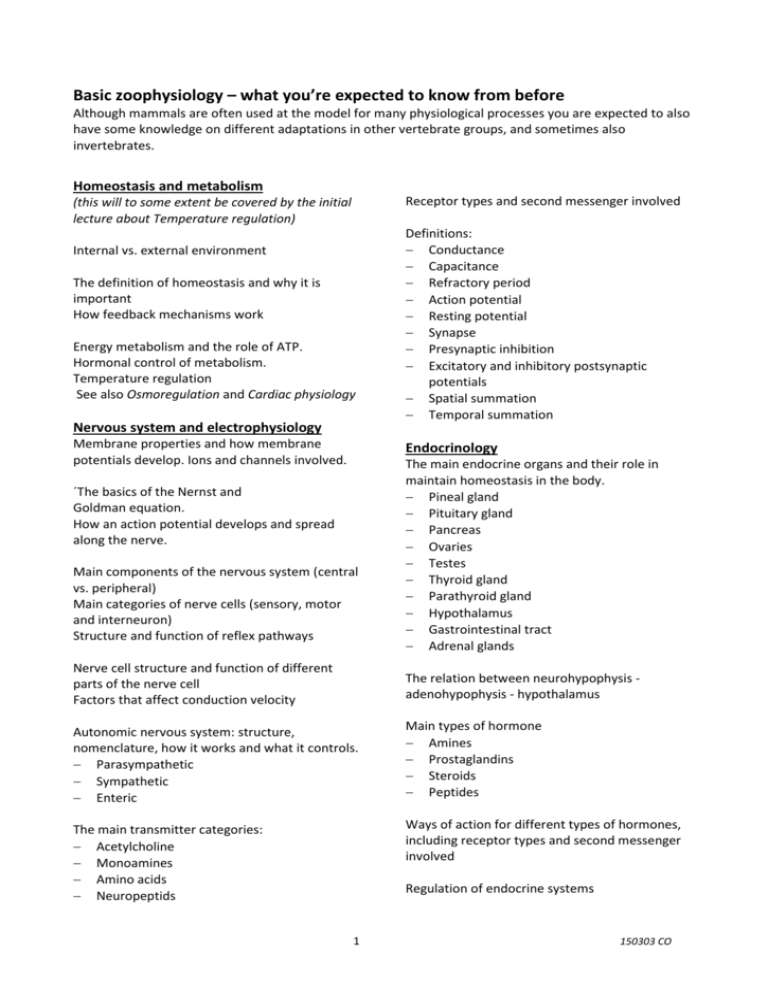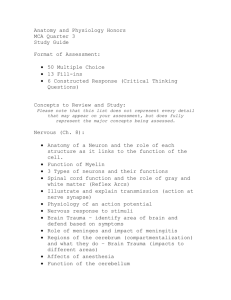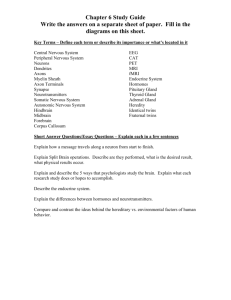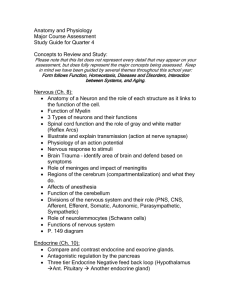BODY - GUL
advertisement

Basic zoophysiology – what you’re expected to know from before Although mammals are often used at the model for many physiological processes you are expected to also have some knowledge on different adaptations in other vertebrate groups, and sometimes also invertebrates. Homeostasis and metabolism Receptor types and second messenger involved (this will to some extent be covered by the initial lecture about Temperature regulation) Internal vs. external environment The definition of homeostasis and why it is important How feedback mechanisms work Energy metabolism and the role of ATP. Hormonal control of metabolism. Temperature regulation See also Osmoregulation and Cardiac physiology Nervous system and electrophysiology Membrane properties and how membrane potentials develop. Ions and channels involved. Definitions: Conductance Capacitance Refractory period Action potential Resting potential Synapse Presynaptic inhibition Excitatory and inhibitory postsynaptic potentials Spatial summation Temporal summation Endocrinology ´The basics of the Nernst and Goldman equation. How an action potential develops and spread along the nerve. Main components of the nervous system (central vs. peripheral) Main categories of nerve cells (sensory, motor and interneuron) Structure and function of reflex pathways The main endocrine organs and their role in maintain homeostasis in the body. Pineal gland Pituitary gland Pancreas Ovaries Testes Thyroid gland Parathyroid gland Hypothalamus Gastrointestinal tract Adrenal glands Nerve cell structure and function of different parts of the nerve cell Factors that affect conduction velocity The relation between neurohypophysis adenohypophysis - hypothalamus Autonomic nervous system: structure, nomenclature, how it works and what it controls. Parasympathetic Sympathetic Enteric Main types of hormone Amines Prostaglandins Steroids Peptides The main transmitter categories: Acetylcholine Monoamines Amino acids Neuropeptids Ways of action for different types of hormones, including receptor types and second messenger involved Regulation of endocrine systems 1 150303 CO Negative feedback Definitions: Autocrine Paracrine Neuroendocrine Endocrine Differences in composition and cell structure in different groups of animals. Thrombocytes Where and how blood cells are produced, how it is regulated. Definitions: Hematocrit Viscosity Muscle physiology Structure and function of different types of muscle cells: Striated muscles Cardiac muscles Smooth muscles Immune system to be expanded Cardiac and circulatory physiology Functional anatomy of the heart and circulatory systems in different groups of animals. "Sliding-filament-theory" – the different components involved and how contraction develops. Role of calcium. Control of muscle activity by nerves and hormones The properties of cardiac muscle cells, how contraction is initiated and spread over the entire heart. Definitions: Isotonic contraction Isometric contraction The relationship between blood flow, blood pressure and the beating of the heart. Other factors that affect blood pressure. Sensory organs Nervous and endocrine control of blood pressure and the heart. Transmitters and receptors involved. The five main senses. Functional anatomy of the eye in different groups of animals Functional anatomy of the ear Receptor types involved in different senses, how they are built and how they function: Chemoreceptors Mechanoreceptors Electroreceptors Thermoreceptors Photoreceptors Receptor adaption to different stimuli, benefits and possible disadvantages. Reflex pathways and receptors involved in maintaining homeostasis: Baroreceptors Chemoreceptors Vasomotor center (VMC) The structure and function of the capillary network. Exchange mechanisms. Lymphatic system – function and general anatomy Definitions: Pacemaker cells Cardiac output Heart rate Stroke volume Systolic end volume Diastolic end volume Blood The main components of blood: Plasma White blood cells (leukocytes) Red blood cells (erythrocytes) 2 150303 CO Osmoregulation and excretion Hemodynamic Laminar flow Tubular flow Plasma skimming Capacitance Resistance TPR ECG Ion and water balance (to maintain homeostasis). Organs and mechanisms involved in exchange between an animal and its surrounding environment (terrestrial and aquatic) Osmoregulators vs. osmoconformers Control system involved (hormones, nerves, feedback signals) in maintaining a constant osmolarity. Respiration Functional anatomy of the respiratory organs (airways, gills etc) in different groups of animals Functional anatomy of the kidneys (or XXX) in different groups of animals Transportation of O2 and CO2 in the blood Structure, function and types of haemoglobin Understand the different steps (secretion and absorption) in the vertebrate kidney involved in urine production. The importance of the counter current -system to produce concentrated urine. Factors that affect gas exchange, both uptake and delivery to the cells (temperature, pH, pressure etc) The relation between pH, CO2 and O2 (Bohr effect) Regulation of kidney function: Renin-angiotensin system Aldosteron ADH Ventilation by lungs – mechanism Ventilation by gills– mechanism Counter-current exchangers – mechanism behind Excretion of nitrogen – differences between animal groups Definitions: Glomerular filtration rate Nephron Clearance Osmosis Hyperosmotic Hypoosmotic Isoosmotic Euryhaline Stenohaline Permeability Voluntary and involuntary (reflexes) control of ventilation rate Mechanoreceptors (stretch) Chemoreceptors (peripheral and central) Definitions: Eupnoea Hyperpnoea Hyper- vs hypoventilation Anatomic and physiologic dead space Tidal volume Residual volume Vital capacity Allosteric interactions Cooperativity Partial pressure Inspiration centre Expiration centre Pneumotactic loop Reproduction The main sex steroids, structure, secretion and control of secretion. Functional anatomy of vertebrate gonads Effect of: Gonadotropin Prolaktin 3 150303 CO Prostaglandins Reproduction cycles: Factors that synchronise cycles, how hormones interact to obtain cyclic patterns. The menstrual cycle vs. oestrus cycle. What happens around fertilization (in primates but also in other groups vertebrates) Digestion Functional anatomy of the gastrointestinal tract, the role of the different parts (e.g. stomach, intestine, liver, pancreas, gallbladder). Understanding of the different cell layers in the gut wall. How food and other particles are transported along the gut. Control of motility. Gastric acid – its role, how it is secreted and the control of secretion Break down of food – chemical (enzymes and acid) and mechanical. Absorption of water and nutrients Definitions: Motility Secretion Absorption Enteric nervous system Suggested reading 4 150303 CO







